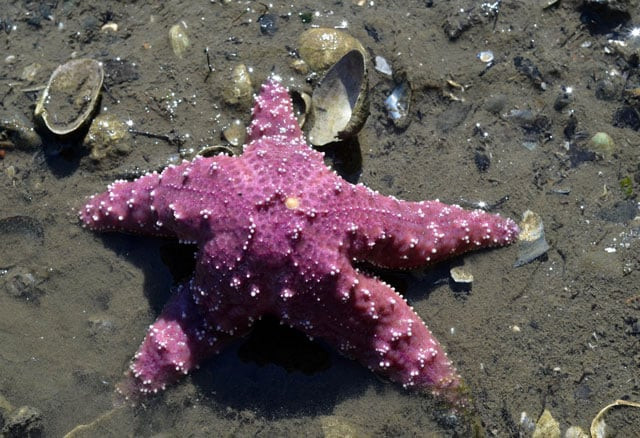Is climate change killing American starfish?
In recent years, millions of starfish, have had their legs curl up and pull away from their bodies

An ochre sea star, (Pisaster ochraceus), also called starfish, is seen at low tide in this July 29, 2015, file photo, on the beach in Bremerton, Washington. PHOTO: AFP
"I don't know what you would call it other than catastrophic," says Drew Harvell, a biologist at Cornell University, describing what is widely regarded as one of the worst marine disease events ever recorded. "It's staggering, really, the millions of stars that have died. It is not apocalyptic or extreme to say that."
Collector by the sea: Shell-shock

In recent years, millions of the starfish, also called sea stars, have had their legs curl up and pull away from their bodies, breaking the animals to pieces before they turn to mush, often in a matter of days. Scientists have been left racing to figure out why.
UN conference delivers climate-saving blueprint
Once densely packed onto the rocks and on the ocean floor, the key predators are simply missing from some locations, their numbers cut by 95 per cent or more.

The phenomenon, called Sea Star Wasting Syndrome, was first noticed by rangers in Olympic National Park in Washington state in 2013.
It has now been documented from California to Alaska, and led to die-off that is bigger and more widely spread than any seen before.
Late last year, a group of researchers published findings in the Proceedings of the National Academy of Sciences saying they had found strong evidence that a virus was causing the disease.

Researchers now are looking into why the virus is suddenly so much more widespread and deadly. A primary consideration is how warmer water, brought about by climate change, is affecting the stars, the virus and the wider ecosystem.
"There are components that certainly track with temperature," Harvell said. "We think the magnitude in our waters is due to temperature. We know that under warmer conditions, they die faster."
"We've had anomalously warm oceans for the last two years. Really, what we would call hot water. It is really the dominant thing to consider," she said.
Rich blamed as world seeks climate pact
A primary challenge for researchers is simply the massive amount of data needed to get a good understanding of what is happening. The animals are found on thousands and thousands of miles of coastline, and sufficient funding is simply not available to thoroughly count them and consider all the possible variables.
But scientists are nevertheless trying. They are tracking the numbers of stars in locations over time, gauging the temperature and chemistry of the water, and logging the data as part of ongoing research into the ecosystem. They are even recruiting "citizen scientists" to help search for the stars and record their condition.
Melissa Miner, a researcher with the University of California at Santa Cruz, is one of the people leading the data collection, but said the widespread nature of the outbreak adds to the challenge.
"It is pretty difficult to collect the data we need on a big scale," she said. "I really want to stress that it isn't understood at all what it is causing this disease."
Rich nations vow billions for climate initiatives
Harvell agreed that money for the extensive research is scarce. It doesn't help that the starfish are not an animal humans eat, and thus there is no industry raising the alarm about their decline.
"Out of sight, out of mind," she said. "We need to be concerned about the health of our oceans. We could be so much farther ahead if there had been enough money available."
Congressman Denny Heck, whose district in Washington state includes much of the inland waters where starfish have been dying off in huge numbers, is trying to help by establishing a framework for declaring a marine disease emergency.
Such a declaration would come with money for research and possible recovery. "When disease like this breaks out underwater, we have no established process to stop it," Heck told AFP.
He has found allies on both coasts, as well as among his fellow Democrats and Republicans, as a disease outbreak could hit fisheries and devastate a local economy, but is not optimistic about the chances of his bill in the Republican-led Congress.
"When I'm home in Washington state, the effects of climate change are all too real. Our salmon are dying due to higher water temperatures, the snowpack at Mount Rainier is disappearing, our waters are becoming more polluted, and the increasingly dry, hot summers are causing massive forest fires," Heck said.
But he says when once back in the US capital, "the same concerns seem to be absent among the (Republican)-controlled Congress, even though I know the communities they represent also have evidence of a serious problem. The urgency from the majority party to deal with these problems just isn't there."
For her part, Miner is hopeful that the colourful sea stars have a high enough profile to draw attention to their demise. "They are as charismatic as you can be as an intertidal species," she said. "They are what connects people to ocean. The sea star is kind of the mascot of the intertidal."



















COMMENTS
Comments are moderated and generally will be posted if they are on-topic and not abusive.
For more information, please see our Comments FAQ